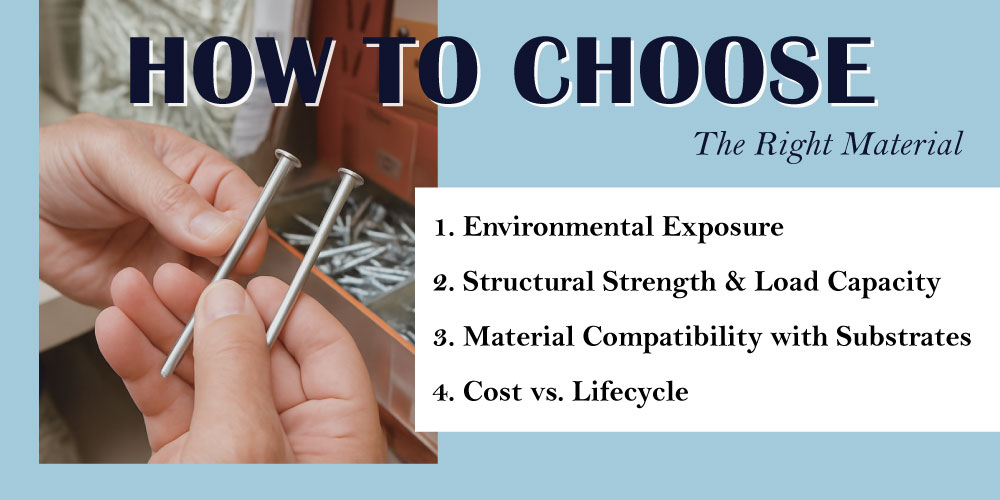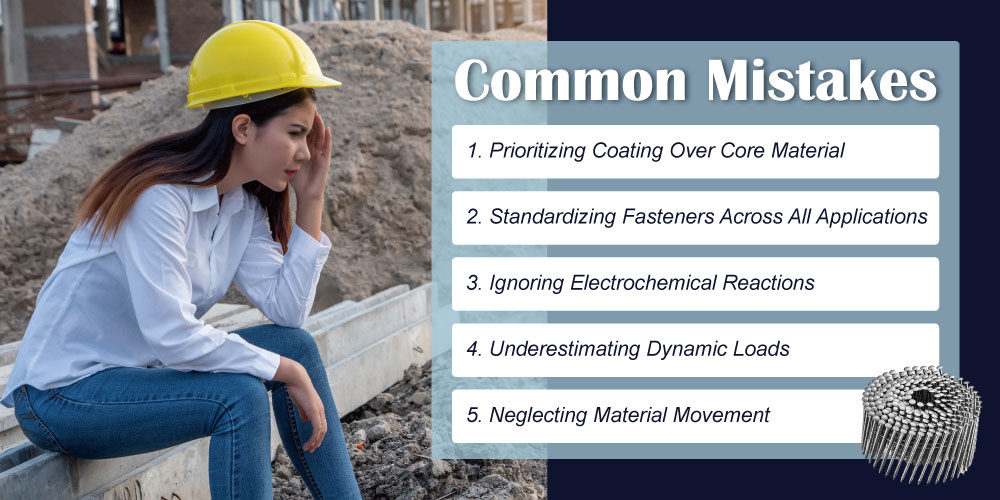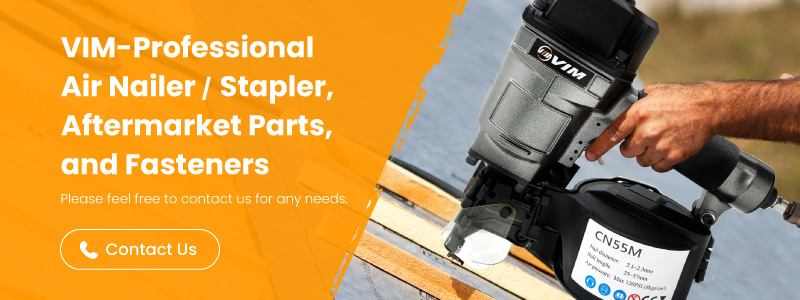Make Every Connection Count: 4 Clear Strategies to Choose the Best Fastener Materials

In most construction failures, attention naturally turns to design errors, load miscalculations, or installation mistakes—and rightly so. But in a surprising number of cases, the issue lies deeper, within the components that hold everything together: the Fastener Materials. While not the most frequent cause of failure, incorrect fastener selection—especially in terms of base material—has repeatedly proven to carry disproportionate consequences.
A nail that corrodes in pressure-treated wood, or a staple that fractures under seismic movement, may seem like minor oversights at first—but in critical environments, they can trigger large-scale failures and costly rework. This guide explores how material choice, often seen as a detail, plays a major role in fastener performance—and why professionals can’t afford to treat it as an afterthought.
Choosing the Right Material for Your Application
 When selecting fastener materials for any structural, decorative, or industrial application, the base material—not just the shape or size—can dramatically affect long-term performance.
When selecting fastener materials for any structural, decorative, or industrial application, the base material—not just the shape or size—can dramatically affect long-term performance.
【Extended reading: Stop Guessing: 13 Proven Fastener Materials for Choosing the Right Nails and Staples 】
1. Environmental Exposure
- Indoor Use
Low-humidity environments like interior carpentry or furniture framing can use carbon steel fasteners. These offer strong holding power at a lower cost—ideal when corrosion isn’t a major concern. - Outdoor or Moist Settings
Choose stainless steel nails and staples for their corrosion resistance. In marine or high-moisture environments, 316-grade stainless steel offers added protection compared to 304-grade. - Lightweight, Non-Load-Bearing Projects
Aluminum fasteners are corrosion-resistant and easy to install, making them suitable for temporary structures or soft materials like plastics or softwoods.
2. Structural Strength & Load Capacity
- Heavy-Duty Structural Framing
In residential or commercial construction, hardened steel nails (such as ring shank or screw shank types) provide superior tensile and shear strength. These are essential for beams, joists, and subfloor assemblies, particularly in seismic or high-wind zones. - Engineered Wood Products
For dense materials like LVL beams or laminated joists, heat-treated nails or hardened fasteners are necessary to ensure penetration without deformation and to maintain structural integrity. - Hardwood or Thick Timber Projects
When working with oak, teak, or other dense woods, hardened staples and nails must resist shearing under load. Flooring applications, in particular, benefit from angle-driven Staples made from high-carbon steel. - Pallet Manufacturing and High-Volume Assembly
In pallet and crate production, coil nails made from carbon steel or plain steel are the standard. Though not hardened, their ring or screw shanks provide reliable holding power for industrial use. These nails balance speed, strength, and cost—ideal for high-volume applications. Optional coatings like electro-galvanized or phosphate finishes can improve corrosion resistance when needed. - Pre-Fixation During Assembly
In prefabrication or on-site assembly, fasteners are often used temporarily to hold components in place before final bolting, welding, or anchoring. In these cases, hardened nails offer the necessary holding power during layout or positioning—especially when speed and precision are required during setup.
3. Material Compatibility with Substrates
- Material Compatibility with Substrates
Selecting the right fastener materials is critical for long-term performance. Chemically and mechanically incompatible choices can lead to corrosion, discoloration, or even nails and staples loosening over time. - Pressure-Treated Lumber
ACQ, CA-B, and MCQ-treated woods contain corrosive copper compounds. For these substrates, prioritize fastener materials like 304/316 stainless steel staples or nails—or silicon bronze in coastal environments. - Composite Decking and PVC Trim
Thermal expansion demands flexible fastening solutions. Stainless steel ring shank nails provide superior grip, while specialized staples for composite boards resist pull-out. - Fiber Cement Boards and Plaster
Highly alkaline surfaces attack standard fastener materials. Ceramic-coated nails or corrosion-resistant staples (for lighter applications) prevent bonding failure. - Aluminum or Zinc Panels
Galvanic corrosion risks rule out steel fastener materials. Match substrates with aluminum/stainless steel nails—low-profile flat heads maintain sleek aesthetics. - Softwoods and Insulation Boards
Prevent over-penetration in pine, cedar, or foam with wide-crown staples or smooth-shank aluminum nails, balancing surface area and holding power.
4. Cost vs. Lifecycle
- Disposable or One-Time Use
When fasteners are used in temporary crates, shipping pallets, or short-term packaging, electro-galvanized carbon steel offers a balance of price and performance. - Long-Term or Mission-Critical Use
In applications where longevity, safety, or aesthetics matter, investing in premium fastener materials like 316 stainless steel or silicon bronze pays off through reduced replacements and superior performance.
Common Mistakes in Material Selection: What Professionals Should Avoid
 Even seasoned professionals make costly fastener materials mistakes—leading to premature failures, safety risks, and expensive rework. Here’s how to avoid the top pitfalls:
Even seasoned professionals make costly fastener materials mistakes—leading to premature failures, safety risks, and expensive rework. Here’s how to avoid the top pitfalls:
【Extended reading: 14 Surface Treatments That Matter: A Closer Look at Fastener Finishing】
1. Prioritizing Coating Over Core Material
A zinc or resin finish might delay corrosion, but if the base fastener material (e.g., carbon steel) is mismatched to the environment—like using mechanical plating in high-friction metal-to-metal joints—coating wear will accelerate.
Fix: Match the core material first (e.g., 316 stainless steel for saltwater), then select coatings (e.g., hot-dip galvanized over electroplated for marine zones).
2. Standardizing Fasteners Across All Applications
Staples for indoor fabrics lack UV resistance for exterior siding, while nails suited for softwood may shear in hardwood due to grain density.
Fix: Maintain a minimal but application-specific inventory (e.g., stainless steel staples for outdoor use; hardened nails for dense lumber).
3. Ignoring Electrochemical Reactions
Plain steel fasteners corrode rapidly in ACQ-treated wood, but even coated screws (e.g., zinc-plated) can fail when paired with copper-preserved substrates.
Fix: Opt for chemically inert fastener materials like silicon bronze or ceramic-coated nails in reactive environments.
4. Underestimating Dynamic Loads
Shear forces in decks or subfloors demand more than diameter/length checks—rigid nails may snap under cyclic loads.
Fix: Use load-rated fastener materials (e.g., structural screws with annular threads for tensile strength).
5. Neglecting Material Movement
PVC and composites expand seasonally; rigid staples or nails cause cracks or loosen over time.
Fix: Flexible fastener materials (e.g., stainless ring shank nails) accommodate movement without sacrificing grip.
Real-World Failures: When Materoal Mistakes Lead to Catastrophe
 When it comes to structural safety and long-term performance, Fastener materials are far more than a procurement detail—they’re a critical design choice. Real-world failures across the globe have demonstrated how improper selection of staples and nails can trigger catastrophic outcomes, especially in modular, seismic, or moisture-prone environments.
When it comes to structural safety and long-term performance, Fastener materials are far more than a procurement detail—they’re a critical design choice. Real-world failures across the globe have demonstrated how improper selection of staples and nails can trigger catastrophic outcomes, especially in modular, seismic, or moisture-prone environments.
【Extended reading: Why Finishing Matters More Than You Think: 4 Mistakes to Avoid in Fastener Coating Selection】
1. Modular Student Housing Collapse (2017, California)
A five-story modular student housing unit in Oakland experienced partial façade failure just 18 months after completion. Investigators traced the issue to corroded galvanized nails, which had been used in place of marine-grade 304 stainless steel fasteners. The coastal environment accelerated corrosion, compromising panel integrity and forcing multi-million-dollar repairss.
Key relevance: Substituting corrosion-resistant fastener materials with cheaper alternatives can create structural liabilities far exceeding any upfront savings.
2. Malmö School Seismic Failure (2014, Sweden)
Three newly constructed schools, designed to withstand seismic activity, suffered internal wall collapses during a relatively moderate 6.5-magnitude earthquake. It was later discovered that standard EN 14566 low-carbon steel staples were installed instead of high-ductility variants. The brittle fracture of these fasteners under dynamic stress highlighted a severe oversight in materials specification.
Key relevance: Even minor differences in fastener materials—particularly ductility—can dramatically affect performance in seismic zones.
3. Melbourne Modular Apartment Failure (2019, Australia)
In a mass timber modular complex, wall panels failed after three years of occupancy due to widespread corrosion of non-galvanized nails. Moisture intrusion had not been anticipated in the fastening strategy, and the rusted nails loosened critical joints.
Key relevance: Non-structural fasteners in timber construction must still meet climate-specific durability requirements. Poor Fastener Material selection led to a cost ratio of 400:1 between damage and savings.
4. Sichuan School Partition Collapse (2008, China)
During the Wenchuan earthquake, multiple school partition walls disintegrated. Post-event analysis showed that low-carbon steel staples used in drywall connections failed due to brittle fracture. Laboratory simulations confirmed that high-ductility fastener materials would have withstood the 0.3g seismic acceleration.
Key relevance: The choice of staple material—especially for lateral load applications—can determine whether a partition remains intact or fails entirely during earthquakes.
Common Real-World Compatibility Pitfalls
| Scenario | What Goes Wrong | Why It Fails |
|---|---|---|
| Low-carbon steel staples used in seismic-rated wall assemblies | Brittle fracture during lateral movement | Low-carbon steel lacks ductility under dynamic load, leading to snap failure instead of plastic deformation during earthquakes. |
| Aluminum nails used in structural timber framing | Pull-through and deformation | Aluminum’s low tensile strength and high softness make it prone to bending or loosening under long-term shear or uplift forces. |
| Unalloyed steel fasteners in marine-grade panels | Accelerated rust and joint failure | Standard carbon steel lacks inherent corrosion resistance in salt-heavy environments; structural performance degrades within months without protective alloying. |
| 304 stainless steel fasteners used in chemically treated wood | Localized pitting and joint discoloration | In contact with high-copper preservatives (e.g., ACQ), even 304 stainless steel may corrode unless upgraded to 316 or polymer-isolated. |
| Brass nails used in load-bearing trusses | Shear failure under load | Brass has poor fatigue strength and work-hardens quickly; it is unsuitable for cyclic structural applications, especially in roofing and modular housing. |
| Hardened carbon steel staples installed in fiber cement panels | Material cracking and detachment | The staples are too rigid and induce localized stress in brittle substrates like fiber cement, leading to edge fracture and delamination. |
Conclusion
Selecting fasteners is no longer just a matter of size, gauge, or head style. With increasing design complexity and harsher environmental demands, the material behind your nails and staples must align with every performance requirement—from seismic resilience to chemical stability. Even the best coating or plating can’t make up for the wrong substrate alloy. Whether you're working with pressure-treated lumber, concrete sheathing, or composite decking, the right Fastener Materials will ensure structural integrity, reduce callbacks, and extend the lifecycle of your build.
At VIM International, we specialize in material-specific fastening solutions for every industry segment. From marine-grade stainless steel nails to high-tensile staples built for engineered wood and seismic zones, our products are engineered to match the demands of modern construction. Don’t risk performance with generic fasteners—talk to us about the right Fastener Materials for your application and get peace of mind built in from the start.
Get in touch with our team and see how VIM can enhance your sourcing decisions with reliable, field-tested components and flexible supply solutions.
Article Classification
Recent Articles
- Every Corrugated Fastener You Want—All Here in One Comprehensive Guide
- The 4 Carton Staples Issues Ruining Your Packaging—Solved in Minutes
- 5 Reasons Why VIM Concrete T Nails Deliver Unmatched Grip and Durability
- The Hidden Force in Every Staple: 9 Point Types That Make Fastening Last
- 8 Expert Facts on Strip Nails for Smarter Fastening Choices

